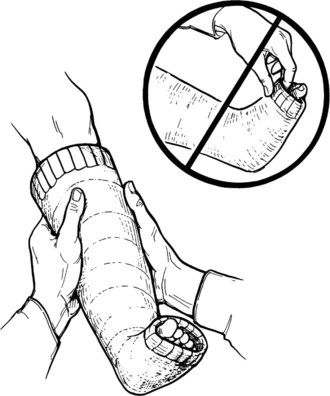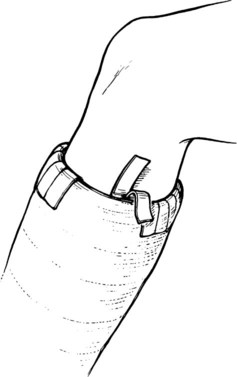This section may be photocopied and distributed to families. Spanish translation of this handout available at http://evolve.elsevier.com/Wong/clinical. Before the cast is applied, a synthetic padding material is used to protect the skin. (Some fiberglass cast material already contains a padding liner.) The cast is then put on over this padding. At first, the cast will feel warm; this will last for about 10 to 15 minutes. A plaster cast will remain damp for many hours, whereas a fiberglass cast will dry within 30 minutes. Do not put anything in the cast while it is drying or afterward. During the drying time, touch the cast as little as possible. If you have to touch the plaster cast, use the palms of your hands, not the fingers (Figure 1). Turning the child in a plaster body cast at least every 2 hours will help the cast dry. Do not use a heated fan or dryer. A regular fan can be used in humid weather to circulate the air. If it is a leg or arm cast, check the color of the toes or fingers. They should be pink and warm to the touch. When the skin in these areas is lightly pressed and released, the skin color should return quickly. To help prevent swelling, raise the arm or leg in the cast above the level of the child’s heart (Figure 2) by resting the cast on several pillows or blankets. If an arm is in a cast, a sling helps support the arm during the day and pillows can be used at night. For leg casts, loosen the covers on the bed at nighttime and place some pillows by the feet to keep the blanket from putting pressure on the toes. During the time the cast is on, special care is needed to keep the skin around the cast healthy. The back of the leg may be irritated when the child is in a short leg cast, and the skin between the thumb and the index finger is often a problem with an arm cast. If the plaster cast rubs against the skin, tape can be used to cover the rough edges of a cast. This is called petaling and involves these steps (Figure 3):
Wilson & Hockenberry: Wong’s Clinical Manual of Pediatric Nursing, 8th Edition
Patient Teaching Guide
Caring for the Child in a Cast
Skin Care
![]()
Stay updated, free articles. Join our Telegram channel

Full access? Get Clinical Tree


Wilson & Hockenberry: Wong’s Clinical Manual of Pediatric Nursing, 8th Edition: Patient Teaching Guide
Get Clinical Tree app for offline access



